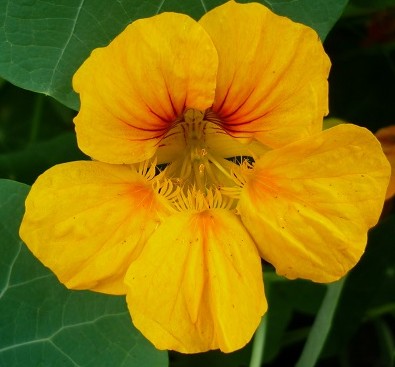 Nasturtium is a trailing herbaceous annual native to the Andes from Bolivia to Colombia. It has naturalized on both coasts of the US and is cultivated in many more areas. The leaves are almost round, peltate, and held on long petioles. The five petaled flowers are spurred, 1 to 2.5 inches across and yellow, orange, or red. They bloom from mid summer to fall and give way to three seeeded fruits inch across. The common name nasturtium comes from the Latin nos meaning nose and tortum meaning twist and refers to the flower’s scent that makes people’s nose twist when they eat it. The common name nasturtium is the genus name for water cress (Nasturtium officianale) that has a similar flavor but is not at all related.
Nasturtium is a trailing herbaceous annual native to the Andes from Bolivia to Colombia. It has naturalized on both coasts of the US and is cultivated in many more areas. The leaves are almost round, peltate, and held on long petioles. The five petaled flowers are spurred, 1 to 2.5 inches across and yellow, orange, or red. They bloom from mid summer to fall and give way to three seeeded fruits inch across. The common name nasturtium comes from the Latin nos meaning nose and tortum meaning twist and refers to the flower’s scent that makes people’s nose twist when they eat it. The common name nasturtium is the genus name for water cress (Nasturtium officianale) that has a similar flavor but is not at all related.
The flavor of Tropaeolum majus is spicy peppery with a hint of bittersweet. All parts of the the plant are edible and the flowers and leaves are commonly used in salad. They may also be used to flavor oils, vinegars, dips, mayonnaise, and black beans cooked with corn . The flowers alone can be incorporated into pizza dough, ice cream, risotto, pancakes, and omelettes, made into jam or hot sauce, or stuffed with cheese or egg, chicken or tuna salad. The pickled flower buds and seed pods can be used like capers.
The flowers should be harvested just a they open. The more stressed the plant by lack of water or nutrients, the more pungent the flavor so sample flowers before picking. Rinse them in water and gently dry before using or storing in plastic bags in the refrigerator for future use. Fifteen to thirty flowers yield one cup.